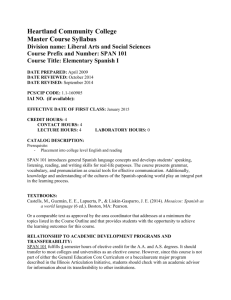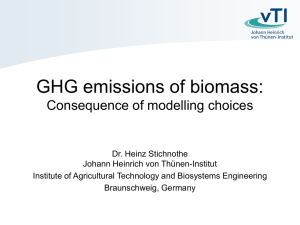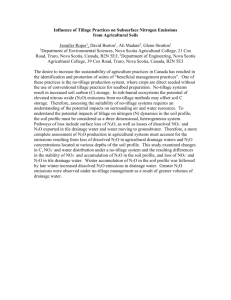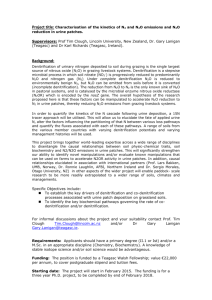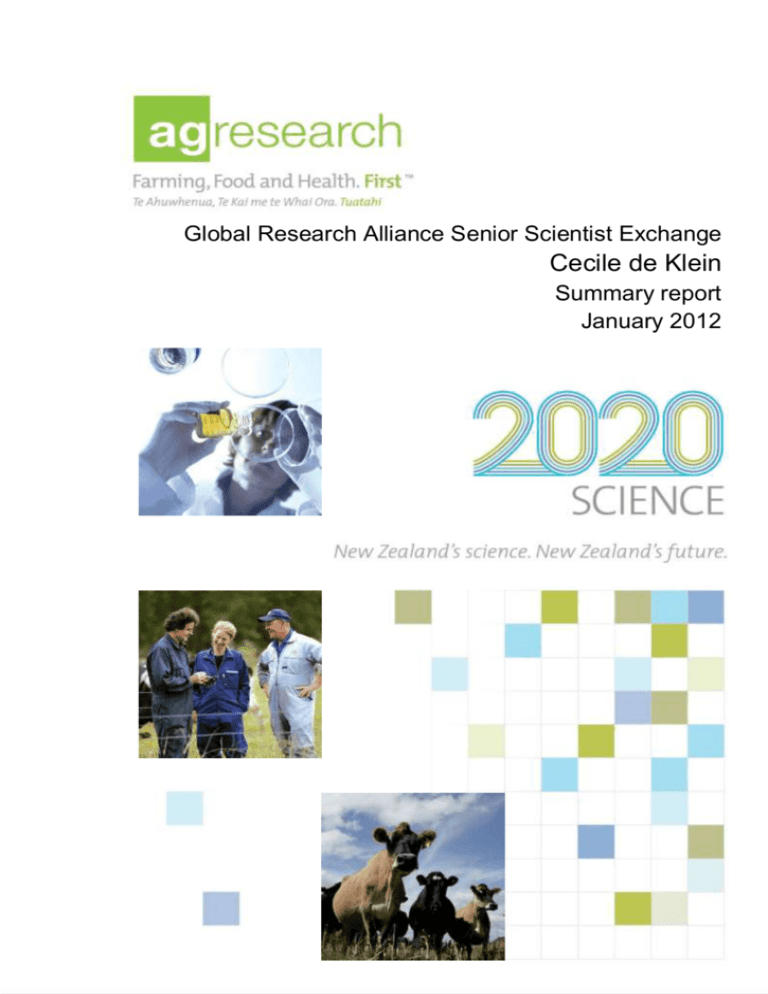
Global Research Alliance Senior Scientist Exchange
Cecile de Klein
Summary report
January 2012
Report prepared for Global Research Alliance
GRASS exchange Cecile de Klein – summary report
January 2012
i
Contents
Contents ............................................................................................................................. ii
1. Introduction ................................................................................................................... 1
2. N2O mitigation research focus ...................................................................................... 1
3. Framework for disaggregating N2O emission factors................................................... 2
4. GRA Livestock Research Group (LRG) activities ........................................................ 3
4.1
Represent LRG at Climate Smart Agriculture conference ................................. 3
4.2
Facilitate collaborations between the two countries ........................................... 3
4.3
Coordinate and facilitate linkages for EOIs for the Global Partnership Fund .... 4
4.4
Present papers at GRA workshop sessions in Reading (UK) and
Amsterdam (NL).................................................................................................. 4
5. Key outcomes of the exchange .................................................................................... 4
6. Key recommendations .................................................................................................. 5
DISCLAIMER: While all reasonable endeavour has been made to ensure the accuracy
of the investigations and the information contained in this report, AgResearch expressly
disclaims any and all liabilities contingent or otherwise that may arise from the use of the
information.
COPYRIGHT: All rights are reserved worldwide. No part of this publication may be
copied, photocopied, reproduced, translated, stored in a retrieval system, or transmitted
in any form or by any means, electronic, mechanical, photocopying, recording, or
otherwise, without the prior written permission of AgResearch Ltd.
Report prepared for Global Research Alliance
GRASS exchange Cecile de Klein – summary report
January 2012
ii
1.
Introduction
This summary report describes the key findings, outcomes and recommendations of
Cecile de Klein’s Global Research Alliance Senior Scientists exchange to Europe
between September and November 2011. A more detailed report was provided to the
GRA and is available at the author’s discretion.
The GRASS exchange had three main components:
1. Identification of new N2O mitigation strategies for NZ dairy systems through learning
from recent advances in European dairy research (NL, UK, France and Ireland).
2. Develop a framework for disaggregating activity data and emission factors and
fraction of the NZ N2O inventory methodology that ensures any gains from N2O
mitigation strategies can be accounted for.
3. GRA Livestock Research Group activities
a. Represent LGR at Climate Smart Agriculture conference
b. Facilitate collaborations between the two countries
c. Facilitate linkages with NZ researchers for EOIs for the Global Partnership Fund
d. Present papers at GRA workshop sessions in Reading (UK) and Amsterdam (NL)
2.
N2O mitigation research focus
The key N2O mitigation options being investigated at the European institutes that were
visited are:
1. Nitrification inhibitors (mainly DCD, but strong interest in evaluating a natural
nitrification inhibitor)
2. Improved fertiliser type/timing to exploit existing spatial and temporal variability in
emissions (‘right place, right time’ management strategies)
3. Increase grazing period (animals out in paddock for longer to minimise NH3 and
other gaseous losses from housing systems)
4. Use clover-based pastures
5. Dietary N strategies
There was also a growing recognition that recent advances in microbial and molecular
techniques will enable development of next generation N2O mitigation options through
better understanding the microbial processes and the functional genes involved with
nitrification and denitrification.
In terms of measurement methodologies, most of the N2O mitigation work was
conducted using N2O chamber methodologies similar to those used in New Zealand.
The team in the UK had an interesting approach by including one automated chamber in
association with their manual chambers, to assess the diurnal variability of fluxes and
thus providing an opportunity to, if necessary, adjust the manual chamber
measurements to represent the average daily flux. Another methodological advance
includes the increasing use of Quantum Cascade Lasers (QCL) for rapid chamber
measurements of both N2O and CH4 emissions.
Report prepared for Global Research Alliance
GRASS exchange Cecile de Klein – summary report
January 2012
1
The European N2O research focus is aligned with current New Zealand research. The
strong similarities between the various research groups provide an excellent opportunity
for collaboration and joint projects could be undertaken to fast-track some of the existing
research programmes in NZ and Europe. Particular opportunities for collaboration exist
through the GRA Global Partnership Fund and also through the newly funded Irish GHG
consortium, which will be setting up the Irish equivalent of the NZAGRC. Discussions
with Dr Gary Lanigan, who leads this initiative, are ongoing to provide input into
research priorities and identification of opportunities for joining forces.
Potential priorities discussed with Gary included (amongst others):
Nitrification inhibitors (with special focus on low cost options)
Improved spatial and temporal N and animal management
Better understanding the microbial processes and the functional genes involved
with nitrification and denitrification
Dietary N strategies
Improving models
Discussions with animal, plant and/or system scientists to develop interdisciplinary projects
Improved methodologies (chambers vs micromet technologies)
3.
Framework for disaggregating N2O emission factors
Members of the Soil Quality and Nutrients team of Altterra’s Soils Science Centre,
Wageningen University & Research centre (WUR)
Researchers at Alterra (NL) have developed a framework for disaggregating N2O
emission factors to account for the variability in soil type, land use, climate and
management practices1. Using this framework, Lesschen et al. (2011) showed that it
provided a more refined/accurate assessment of the N2O emissions from the 27 EU
member states and that it could allow accounting for the effect of mitigation measures.
1
Lesschen JP, Velthof GL, de Vries W, Kros J (2011) Differentiation of nitrous oxide emission factors
for agricultural soils. Environmental pollution 159: 3215-3222
Report prepared for Global Research Alliance
GRASS exchange Cecile de Klein – summary report
January 2012
2
The applicability of the current framework for New Zealand systems is relative limited as
from the 84 disaggregated EF values, only about 12 values are of relevance for New
Zealand. Furthermore, the current NZ N2O inventory can already account for N2O some
mitigation strategies (e.g. nitrification inhibitors and dietary manipulation). To enable
mitigation strategies that exploit the spatial and temporal variability of N2O emissions
(e.g. improved timing and place of fertiliser or grazing management) to be fully
accounted for, emission factors and fractions will need to be seasonally or temporally
disaggregated. Seasonal or temporally differentiated N2O emission factors are a key
requirement for capturing the full effectiveness mitigation strategies2.
Based on the insights gained from the Dutch framework and on existing knowledge of
the New Zealand emission factors and fractions the following components are
recommended for a disaggregation framework for NZ’s N2O emission factors:
- N input (Cattle urine, Cattle dung, Sheep urine, Sheep dung, Urea)
- Nitrification inhibitor/urease inhibitor adjustment factor
- Seasonal rainfall intensity or wetness (a adjustment factor for the EF for each input,
either based on average seasonal rainfall or on a functional relationship between EF
and soil wetness3)
- Soil type (drainage class – linked to soil wetness relationship above)
- Soil fertility status (e.g. highly improved, improved, developing, unimproved pasture)
- Diet (type and N content)
4.
GRA Livestock Research Group (LRG) activities
4.1 Represent LRG at Climate Smart Agriculture conference
On behalf of the LRG, I co-organised with Dutch colleagues a half-day workshop
session on GHG measurements vs mitigation. I then chaired the workshop session
during the conference. The key outcomes were:
- Representing/profiling NZ LRG at the conference
- Better insight into the tension between global and national GHG reduction targets.
- Contributing to the discussion on whether research should focus on improving
measurements and assessments of GHG emission or on developing mitigation
strategies. Emissions are notoriously variable and estimates thus uncertain, but we
should not let the lack of precise measurements be a barrier for in-action. Instead,
we should embrace this variability and exploit it to our benefit and target peak
emission events.
4.2 Facilitate collaborations between the two countries
The discussions with Dr Jac Meijs prior and during the Climate Smart Agriculture
conference contributed to identifying potential research priorities. They also highlighted
the tension between priorities for achieving global GHG reduction targets vs. achieving
the targets of individual countries. In addition, discussions were held with Paul
2
de Klein CAM, Pacheco D, Rollo M, Gongol C (2011) Effect of greenhouse gas (GHG) mitigation
measures on New Zealand’s GHG inventory. Report prepared for Ministry of Agriculture & Forestry.
October 2011. Pp 30
3 Van der Weerden TJ, Kelliher FM, de Klein CAM (2011) Influence of pore size distribution and soil
water content on nitrous oxide response curves. Soil Research (under review).
Report prepared for Global Research Alliance
GRASS exchange Cecile de Klein – summary report
January 2012
3
Vriesekoop (who leads the non-ruminant area of LRG) on his document ‘Identifying key
factors for GHG mitigation’. This document provides an overview of the key drivers of
GHG emissions and thus aims to help set priorities for LRG initiatives. Further
discussions between NZ and NL were held directly between the co-chairs and
coordinators at the GRA session at the NCGG6 symposium in Amsterdam.
4.3 Coordinate and facilitate linkages for EOIs for the Global
Partnership Fund
Opportunities for partnerships and collaboration on projects were discussed with the
Dutch, Irish and UK research groups and linkages were facilitated between these groups
and the NZ researchers preparing relevant EOIs. Various collaborative EOIs were
subsequently submitted. Being in Europe during the EOI submission process allowed
me to gain some insights on the application process from a partnership perspective and
some recommendations have been made that could hopefully be of use for future GRA
Global Partnership rounds.
4.4 Present papers at GRA workshop sessions in Reading (UK) and
Amsterdam (NL)
The workshop in Reading was a UK GRA initiative and focused on the latest advances
in GHG measurement methodologies, while the session in Amsterdam was part of the
6th Non-CO2 GHG symposium. At both workshops I gave a presentation on the LRG
supported project on the development of guidelines for chamber methodologies. The
need for the development of the guidelines was well recognised and the presentations
were an excellent opportunity to profile and highlight the LRG initiatives in New Zealand.
5.
Key outcomes of the exchange
Identification of key opportunities for collaboration with key European countries to
measure N2O emissions and develop mitigation strategies, especially:
o Low cost Nitrification Inhibitors (e.g. the natural inhibitor, NEEM)
o Decision support systems for ‘right place, right time’ N grazing management
and fertiliser applications
o Developing optimised dairy systems that incorporate some of the
benefits/efficiencies of European housing systems into our low cost pasturebased systems
o Better understanding the microbial processes and the functional genes
involved with nitrification and denitrification.
o Quantum Cascade Laser ‘fastbox’ N2O and CH4 measurement technology
Identification of components for a NZ framework for disaggregating emission factors
so that mitigation strategies can be accounted for
Profiling and representing NZ GRA and LRG
Insights into European environmental issues and policy approaches and recognition
that policy instruments have been the key drivers of change in Europe
Recognition that further advances in N2O mitigation will require much stronger interdisciplinary interaction and collaboration
Report prepared for Global Research Alliance
GRASS exchange Cecile de Klein – summary report
January 2012
4
6.
Key recommendations
Continue close linkages with research groups (e.g. through joint PhD projects), in
particular the Irish and UK groups to develop collaborative projects on the mitigation
strategies identified above.
Enhance development of NZ capability in (soil) microbial and molecular techniques
through closer linkages with the overseas teams as well as with the NZ (microbial
and molecular) CH4 mitigation programmes.
Consider further investigating the value of QCL technology for measuring N2O and
CH4 emissions.
Consider funding a project to further develop the proposed framework for
disaggregating N2O emission factors for the NZ inventory.
Encourage inter-disciplinary GRASS exchanges.
Report prepared for Global Research Alliance
GRASS exchange Cecile de Klein – summary report
January 2012
5
Experimental set-up for
measuring the effect of
a nitrification inhibitor
and the N concentration
in urine on N2O
emissions and N
leaching. Teagasc,
Johnstown Castle,
Wexford, Ireland
Experimental set-up for
measuring N2O and CH4
emissions from
denitrification trenches
or bioreactors. Teagasc,
Johnstown Castle,
Wexford, Ireland
Automated N2O chambers deployed at
Rothamsted Research, North Wyke.
Report prepared for Global Research Alliance
GRASS exchange Cecile de Klein – summary report
January 2012
6


